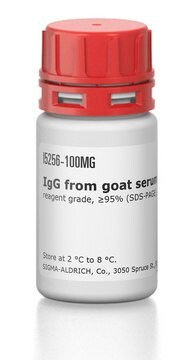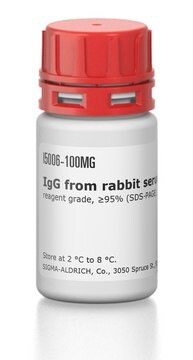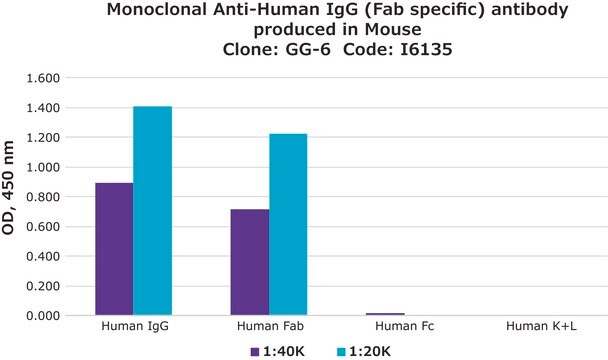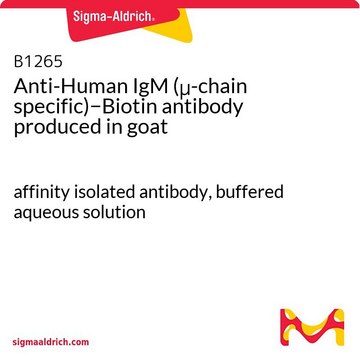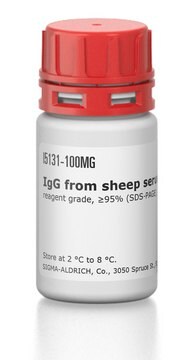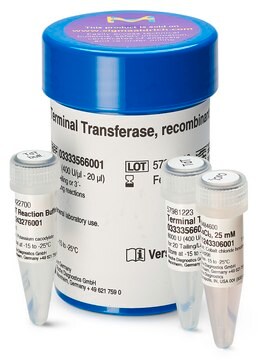推荐产品
共軛
unconjugated
等級
technical grade
化驗
≥80% (SDS-PAGE)
形狀
buffered aqueous solution
技術
ChIP: suitable
immunohistochemistry: suitable
運輸包裝
dry ice
儲存溫度
−20°C
正在寻找类似产品? 访问 产品对比指南
一般說明
Goat IgG is a glycoprotein antibody that is fractionated from pooled normal goat serum. In immunoelectrophoresis, goat IgG yields a single major arc of precipitation in the γ region against anti-goat IgG and anti-goat whole serum. Minor γ arcs may also be observed against anti-goat whole serum.
IgG antibody subtype is the most abundant serum immunoglobulins of the immune system. It is secreted by B cells and is found in blood and extracellular fluids and provides protection from infections caused by bacteria, fungi and viruses. Maternal IgG is transferred to fetus through the placenta that is vital for immune defence of the neonate against infections
Goat IgG is purified from normal goat serum by fractionation.
Goat IgG is purified from normal goat serum by fractionation.
應用
In immunohistochemical applications, IgG from goat serum can be used as a blocking agent (500 μg/ml in paraformaldehyde-fixed mouse uterus sections) or as a negative control (1:56000 in pig cecal tissue).
Technical grade IgG may be used as an economical alternative to the reagent grade immunoglobulins, in applications where high purity is not required. Goat IgG was used as negative control antibody in immunohistochemical staining of cecal tissue of pigs at a dilution of 1:56000. Goat IgG was used in immunohistochemistry of rat brain sections at a concentration of 2 μg/ml. The antibody was also used in chromatin immunoprecipitation and as control in infection inhibition assay.
外觀
Solution in 0.01 M phosphate buffered saline, pH 7.2 containing 15 mM sodium azide
免責聲明
Unless otherwise stated in our catalog or other company documentation accompanying the product(s), our products are intended for research use only and are not to be used for any other purpose, which includes but is not limited to, unauthorized commercial uses, in vitro diagnostic uses, ex vivo or in vivo therapeutic uses or any type of consumption or application to humans or animals.
儲存類別代碼
10 - Combustible liquids
水污染物質分類(WGK)
WGK 3
閃點(°F)
Not applicable
閃點(°C)
Not applicable
個人防護裝備
Eyeshields, Gloves, multi-purpose combination respirator cartridge (US)
其他客户在看
Jan Gunnar Sørbø et al.
FEBS letters, 581(25), 4884-4890 (2007-09-28)
Aquaporin-4 (AQP4) has been reported to be upregulated post-partum in pregnancy and in early lung development. Several technical challenges exist in measuring AQP4 protein levels, among them sensitivity to detergent solubilization, sample heating and gel composition. Here we have optimized
Malene M Nørgaard et al.
The Southeast Asian journal of tropical medicine and public health, 36(6), 1394-1398 (2006-04-14)
The pig has been proposed as a model for human schistosomiasis japonica and the use of this animal model is increasing. The inflammatory response to schistosome infection in the liver and intestine of the pig shows morphological differences, and only
Michael Curley et al.
Scientific reports, 9(1), 15037-15037 (2019-10-23)
Exogenous androgen replacement is used to treat symptoms associated with low testosterone in males. However, adverse cardiovascular risk and negative fertility impacts impel development of alternative approaches to restore/maintain Leydig cell (LC) androgen production. Stem Leydig cell (SLC) transplantation shows
R Froehlich et al.
Placenta, 33(3), 195-201 (2012-01-14)
The concept of a network within the family of adhesion/growth regulatory galectins implies distinct spatio-temporal expression profiles. To test this assumption immunohistochemically for bovine placenta, placentomal (P) and interplacentomal tissues (IP) were collected at a slaughterhouse from the three stages
Michio Kitajima et al.
Archives of histology and cytology, 67(5), 465-474 (2005-03-23)
The arylhydrocarbon receptor (AhR) is a nuclear transcription factor mediating toxic effects of chemicals such as dioxins. The 2,3,7,8-tetrachlorodibenzo-p-dioxin (TCDD), a member of polyhalogenated aromatic hydrocarbons family, exerts a wide-variety of toxic effects in a tissue- and species-specific manner including
我们的科学家团队拥有各种研究领域经验,包括生命科学、材料科学、化学合成、色谱、分析及许多其他领域.
联系技术服务部门